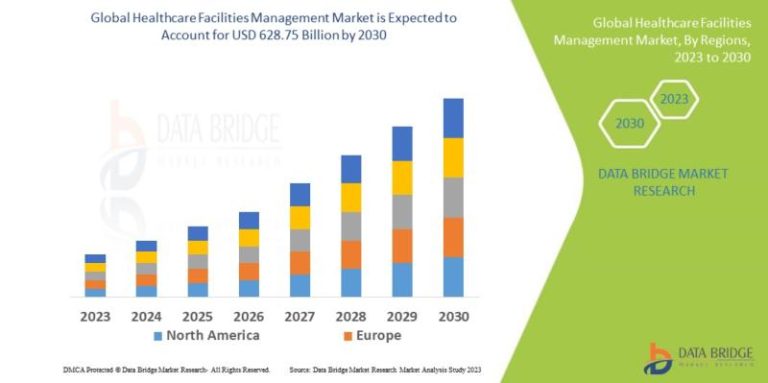
The healthcare sector has experienced dramatic changes in recent years, and healthcare facility management (FM) is a key element of this change. This field focuses on managing and maintaining the infrastructure, equipment, and services within a healthcare facility to ensure a seamless, safe, and efficient environment for patients, staff, and visitors. From hospitals and clinics to nursing homes and specialty care centers, healthcare FM plays a critical role in maintaining standards of hygiene, patient safety, and operational efficiency, and serves as an integral part of a healthcare organization's operational and strategic framework. It has become essential to both.
Market size for medical facility management
The healthcare FM industry has experienced robust growth due to increasing demand for better healthcare infrastructure, rising patient expectations, and an aging global population. As of the latest data, the global healthcare facility management market size is estimated at more than $300 billion and is expected to grow at a compound annual growth rate (CAGR) of approximately 8% over the next few years. This growth trajectory reflects increased investment in health systems globally, as both the public and private sectors recognize the need to modernize infrastructure and facilities.
Rising prevalence of chronic diseases and increasing demand for more healthcare facilities across the world are major contributors to the expansion of this market. Additionally, the COVID-19 pandemic has highlighted the need for resilient health infrastructure and encouraged countries to prioritize health investments. As the demand for advanced medical facilities increases, the healthcare FM market size is expected to match this demand and expand in parallel with the growth in healthcare spending.
Market share and major players
The healthcare FM market is populated by several major players offering a wide range of services, from hard services (maintenance and repair of building structures, electrical systems, etc.) to soft services (cleaning, waste management, etc.). Major players in the market include Compass Group, ABM Industries, Sodexo, Aramark, and Jones Lang LaSalle (JLL). These companies are responsible for providing end-to-end management solutions to healthcare facilities around the world, helping them streamline daily operations, ensure regulatory compliance, and improve the quality of patient care.
For example, Sodexo and Compass Group have gained significant market share through integrated FM solutions that include cleaning, infection control, and equipment maintenance. The company's services are particularly recognized for its ability to help healthcare facilities meet regulatory standards and provide a safe environment for both patients and healthcare professionals. Aramark and ABM Industries, on the other hand, are known for their focus on increasing the operational efficiency of healthcare facilities by providing cost-effective management solutions.
In terms of market segmentation, North America and Europe lead the global healthcare FM market. This is primarily due to advanced healthcare infrastructure, high healthcare spending, and early adoption of integrated FM solutions in these regions. However, the Asia-Pacific region is witnessing rapid growth due to increased healthcare investment, especially in countries where healthcare infrastructure development is a priority, such as China, Japan, and India.
Evolution of medical facility management
Healthcare FM has evolved significantly over the past few decades. Initially, healthcare facility management focused primarily on cleaning and maintenance functions, but has since evolved into a highly sophisticated field with a strategic focus on patient safety, infection control, energy efficiency, and regulatory compliance. Expanded. This change is primarily due to the increasing complexity of healthcare delivery and the demand for safer and more efficient healthcare environments.
The evolution of the industry has been marked by the introduction of digital technologies such as computerized maintenance management systems (CMMS) and Internet of Things (IoT) devices that can monitor facility conditions in real time. CMMS platforms are used to schedule and track maintenance tasks to ensure that equipment and infrastructure are functioning optimally. Meanwhile, IoT devices enable predictive maintenance, allowing facilities to avoid costly equipment failures by identifying potential problems before they become serious.
Infection control has also become an area of focus, especially post-COVID-19, with FM providers emphasizing disinfection and hygiene practices to prevent hospital-acquired infections (HAIs). Today's healthcare FM professionals understand and implement advanced cleaning protocols, HVAC (heating, ventilation, and air conditioning) system maintenance, and waste disposal processes to ensure a safe environment for everyone. is required.
Market trends for medical facility management
The healthcare FM industry is being shaped by several key trends, with technology adoption at the forefront. Digital solutions, particularly in the areas of automation, artificial intelligence (AI), and machine learning, are transforming the way healthcare facilities are managed. For example, AI-powered systems can optimize energy use in facilities, reduce maintenance costs, and ensure regulatory compliance. Similarly, robotic cleaning systems are being introduced in medical settings to accurately perform repetitive cleaning tasks, thereby improving overall hygiene standards.
A focus on sustainability and energy efficiency is also an important trend. Many healthcare facilities are increasingly focused on reducing their carbon footprint by implementing energy-efficient lighting, water-saving systems, and sustainable waste disposal methods. In addition to the environmental benefits, these practices lead to significant cost savings that can be reinvested in patient care and facility improvements.
Another trend shaping the industry is the growing demand for outsourced FM services. Many healthcare providers choose to partner with specialized FM companies to ensure compliance with strict medical standards, reduce operating costs, and focus more on core healthcare delivery. This shift to outsourcing has become popular among both public and private healthcare organizations, allowing them to leverage the expertise and resources of FM providers to streamline operations.
Factors driving growth in healthcare facility management
There are several factors driving the growth of the healthcare FM market. One of the key factors is the increasing need for regulatory compliance in the healthcare sector. Healthcare facilities are subject to stringent health, safety and environmental regulations, so implementing an efficient FM system is essential to ensuring compliance. Failure to comply with these regulations can result in significant fines and damage to your institution's reputation. As a result, healthcare providers are making significant investments in FM to meet these regulatory requirements and maintain safety standards.
Increasing awareness of the importance of infectious disease control is also a major driving force. Because HAIs pose a significant risk to patient safety, healthcare facilities have implemented strict cleaning and hygiene protocols to minimize the risk of infection. FM providers are on the front lines of this fight, offering specialized cleaning and waste disposal services to help prevent the spread of infection within healthcare facilities.
Demand for energy-efficient and sustainable facilities is also driving growth in this sector. Because healthcare facilities consume large amounts of energy and generate large amounts of waste, healthcare FM is increasingly focusing on energy management, recycling, and sustainable waste disposal practices. These practices not only support environmental goals but also reduce operational costs, making them attractive to healthcare providers.
Finally, increased investment in healthcare infrastructure, especially in emerging countries, is creating new opportunities for healthcare FM providers. Countries in Asia Pacific, the Middle East, and Latin America are investing heavily in health infrastructure, with new hospitals, clinics, and specialized treatment centers being built to meet the needs of their growing populations. These facilities require robust FM systems to operate effectively, provide a safe and comfortable environment for patients and staff, and further drive market growth.
See trend report:
https://jondevide92.blogspot.com/2024/10/agriculture-films-and-bonding-market_28.html
https://jondevide92.blogspot.com/2024/10/cloud-security-market-size-share-key.html
https://jondevide92.blogspot.com/2024/10/nutritional-food-market-size-share_28.html
https://jondevide92.blogspot.com/2024/10/internet-protocol-television-iptv_28.html
conclusion
Healthcare facility management is an integral part of the healthcare industry, playing a critical role in ensuring patient safety, operational efficiency, and regulatory compliance. As the industry rapidly grows due to factors such as increased investment in healthcare, regulatory requirements, and the introduction of digital technologies, healthcare FM is evolving to meet the needs of modern healthcare facilities. As the industry continues to innovate and adapt, there is no doubt that it will remain central to creating a safe, efficient and sustainable healthcare environment for years to come.
inquiry:
Data Bridge Market Research
USA: +1 614 591 3140
UK: +44 845 154 9652
Asia Pacific: +653 1251 975
Email: corporatesales@databridgemarketresearch.com”
About Data Bridge Market Research:
Data Bridge has established itself as an unconventional and novel market research and consulting firm with an unparalleled level of resiliency and an integrated approach. We are determined to discover the best market opportunities and facilitate efficient information for your business to succeed in the market. Data Bridge strives to provide the right solutions to complex business challenges and starts the decision-making process with ease.
This release was published on openPR.

